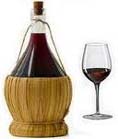Plates - 5
from Italian Traditional Food
Earthenware plates
Check out these great Italian ideas at Amazon for Italian food and kitchen ideas.
<< Previous Page 5 Next
>>
More on the potted history of plates
....
Eartenware development
Earthenware itself, at first glance,
may not seem a very exciting subject but as with most things, the more you learn, the more fascinating it becomes
and you get great satisfaction out of identifying the various types. It was, after all, the earliest form of
pottery known to man.
Earthenware is made of clay that has
been baked at a relatively low temperature. It is porous and in order to hold liquid, needs a glaze. These glazes
can be opaque or translucent and the style of decoration varies accordingly. If earthenware is returned to the kiln
and fired a second time at a higher temperature, it becomes non-porous - stoneware - the kind that Josiah Wedgwood
later refined into his famous creamware.
German potters of the 15th century
had discovered how to glaze the surface of stoneware by throwing salt into the kiln at the second firing, and the
Dutch Elers brothers are often credited with bringing this knowledge to Staffordshire. They also fined down their
own red stoneware by turning their pots on a lathe, and set a worthy example to be followed. But it is also said
that they guarded their production secrets so closely that they only employed the most ignorant workmen, and a
rival, Thomas Astbury, learnt much when he obtained employment at their factory by posing as an
idiot.
Astbury later introduced patterns of
"white slip" on to his wares. Slip is potters' clay that has been diluted, and can be used to draw or splash
designs on to the pot, which is then dipped into a glaze and fired. "Slip marbling", made by applying thin lines of
coloured slip in two or more shades, then working them together by means of a comb or sponge, was recorded as early
as the 17th century, and continued until late Victorian times.
Mocha
ware
Mocha ware so-called because its
style of decoration resembles mocha-stone quartz, is easily recognisable, though none has been made for over 80
years. The body was first covered with yellow or brown slip, and then a pigment containing an infusion of tobasco
and hops was trickled over the surface, spreading into mossy, ferny or feathery blotches. Mugs and jugs with this
type of decoration were used "for public house service" and the ones produced after 1824 have an excise mark
applied by the Weights and Measures officer. There are others, alas, with no excise marks and very thick and heavy
bases....
Creamware
Creamware, is a refined kind of earthenware and the forerunner of
the kind of tableware many of us use in our homes today. It was first produced in the 1730s, and potters such as
Astbury, Ralph Wood and Thomas Whieldon are associated with its early development. It met the demand, both here and
on the Continent, for something more refined than the rougher kitchen earthenware, but less costly than fashionable
oriental porcelain.
The early Staffordshire pieces are of a buttery-yellow colour and
plates and teapots were often covered with characteristic splashes of brown and greeny
glaze to hide the coarseness of the ware. Josiah Wedgwood experimented with it and refined it to a fine, light,
white quality, for which he is still justly famous. From then on it outstripped even porcelain in popularity and
was produced in quantity for Britain and the Continent. It also made a fortune for Wedgwood.
Then Leeds began to use a very high quality creamware, rather
yellower in tone than Wedgwood's; some people prefer this variety - certainly it is much admired today,
particularly for its characteristic perforated designs. Since much of it was sold abroad and, on the Continent,
import tax on ceramics was levied by weight, the perforations were of more than merely decorative use, giving Leeds
ware the edge over its competitors.
Page 6 of this Italian Traditional Food article on plates can be found on the next
page.
<<
Previous Page 5
Next >>

Copyright © 2009 -
. All Rights Reserved Worldwide. Italian Traditional Food
You may not reprint articles from this website
without the written permission of the site owner.
Disclaimer: Articles on this
Website are provided for information purposes only. Italiantraditionalfood.com does not accept any responsibility
or liability for the use or misuse of the article content on this site or reliance by any person on the site's
contents.
| 


 Digg
Digg Stumbleupon
Stumbleupon Google Bookmarks
Google Bookmarks Delicious
Delicious Twitter
Twitter Facebook
Facebook Yahoo My Web
Yahoo My Web Reddit
Reddit